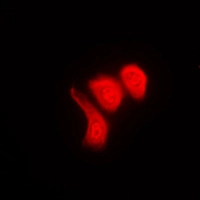![WB analysis of HeLa cell lysate using GTX80387 hnRNP K antibody [3C2]. Dilution : 1:1000 WB analysis of HeLa cell lysate using GTX80387 hnRNP K antibody [3C2]. Dilution : 1:1000](https://www.genetex.com/upload/website/prouct_img/normal/GTX80387/GTX80387_20180331_WB_w_23061322_641.webp)
WB analysis of HeLa cell lysate using GTX80387 hnRNP K antibody [3C2]. Dilution : 1:1000
hnRNP K antibody [3C2]
GTX80387
ApplicationsFlow Cytometry, ImmunoFluorescence, ImmunoPrecipitation, Western Blot, ChIP Chromatin ImmunoPrecipitation, ELISA, ImmunoCytoChemistry
Product group Antibodies
TargetHNRNPK
Overview
- SupplierGeneTex
- Product NamehnRNP K antibody [3C2]
- Delivery Days Customer9
- Application Supplier NoteWB: 1:1000. FACS: 1microg for 10^6 cells. *Optimal dilutions/concentrations should be determined by the researcher.Not tested in other applications.
- ApplicationsFlow Cytometry, ImmunoFluorescence, ImmunoPrecipitation, Western Blot, ChIP Chromatin ImmunoPrecipitation, ELISA, ImmunoCytoChemistry
- CertificationResearch Use Only
- ClonalityMonoclonal
- Clone ID3C2
- Concentration1 mg/ml
- ConjugateUnconjugated
- Gene ID3190
- Target nameHNRNPK
- Target descriptionheterogeneous nuclear ribonucleoprotein K
- Target synonymsAUKS; CSBP; dC-stretch binding protein; heterogeneous nuclear ribonucleoprotein K; HNRPK; transformation upregulated nuclear protein; TUNP
- HostMouse
- IsotypeIgG2b
- Protein IDP61978
- Protein NameHeterogeneous nuclear ribonucleoprotein K
- Scientific DescriptionThis gene belongs to the subfamily of ubiquitously expressed heterogeneous nuclear ribonucleoproteins (hnRNPs). The hnRNPs are RNA binding proteins and they complex with heterogeneous nuclear RNA (hnRNA). These proteins are associated with pre-mRNAs in the nucleus and appear to influence pre-mRNA processing and other aspects of mRNA metabolism and transport. While all of the hnRNPs are present in the nucleus, some seem to shuttle between the nucleus and the cytoplasm. The hnRNP proteins have distinct nucleic acid binding properties. The protein encoded by this gene is located in the nucleoplasm and has three repeats of KH domains that binds to RNAs. It is distinct among other hnRNP proteins in its binding preference; it binds tenaciously to poly(C). This protein is also thought to have a role during cell cycle progession. Several alternatively spliced transcript variants have been described for this gene, however, not all of them are fully characterized. [provided by RefSeq, Jul 2008]
- Storage Instruction-20°C or -80°C,2°C to 8°C
- UNSPSC12352203

![WB analysis of whole cell extracts (30 microg lysate) of HeLa (Lane 1), PANC-1 (Lane 2), MCF7 (Lane 3), U-2 OS (Lane 4), U-87 MG (Lane 5), IMR-32 (Lane 6), HT-29 (Lane 7) and tissue extract of Rat Testis (Lane 10) using GTX15882 hnRNP K antibody [F45 P9 C7]. Dilution : 2 microg/ml](https://www.genetex.com/upload/website/prouct_img/normal/GTX15882/GTX15882_1550_WB_w_23060620_704.webp)



